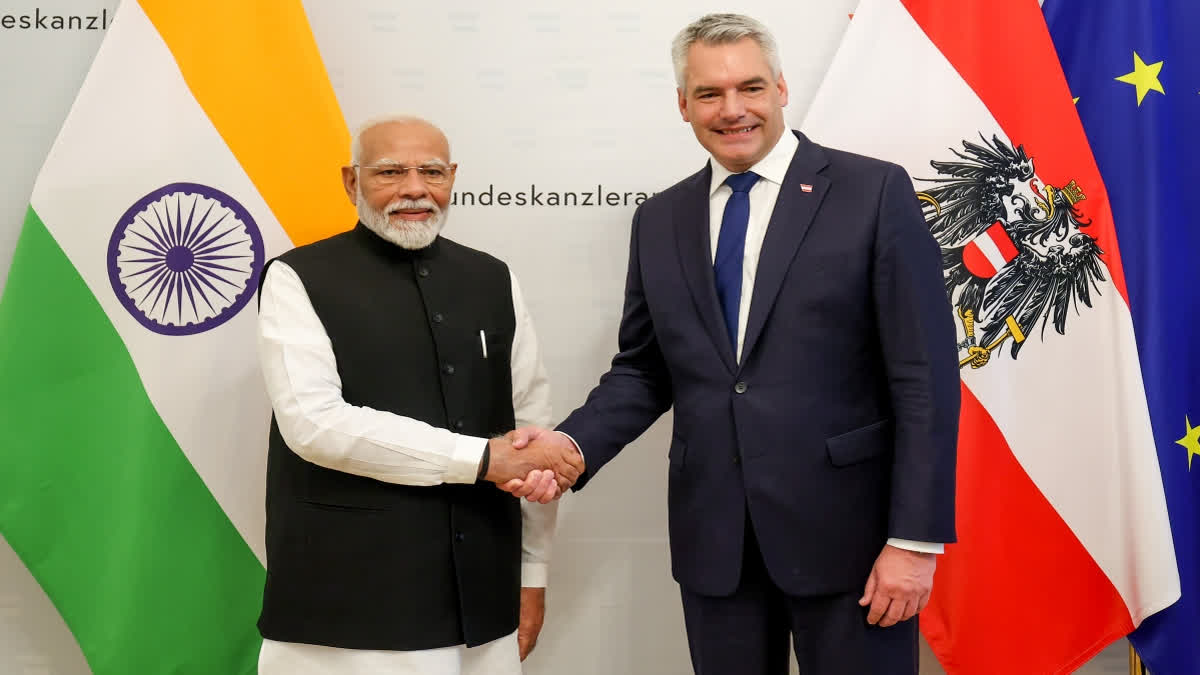New Delhi: During his joint address to the media with Austrian Chancellor Karl Nehammer following delegation-level talks in Vienna on Wednesday, Prime Minister Narendra Modi said that both India and Austria have decided to provide a strategic direction to the bilateral relationship and a blueprint in this regard has been prepared.
"This is not limited to economic cooperation and investment alone," PM Modi said. "We will work to combine our strengths in areas such as infrastructure development, innovation, renewable energy, hydrogen, water and waste management, artificial intelligence, and quantum technology. To connect the youth and ideas of both countries, the startup bridge will be accelerated."
Later, speaking at a meeting of Indian and Austrian CEOs from diverse sectors, PM Modi called on Austrian business stakeholders to take advantage of the fast-unfolding business opportunities in India. He also spoke about India's success in the field of startups, in the creation of next-generation infrastructure, and its commitment to forge ahead on the green agenda.
It is worth mentioning that there are around 30-40 Austrian companies in India working in a range of areas from infrastructure development to tunnelling and railway track-laying. What are Austria's strengths in the areas PM Modi mentioned that India can take advantage of?
Transport infrastructure: Austria boasts a well-maintained and extensive road network that includes high-speed highways (autobahns), federal roads, and local roads. The country’s road infrastructure is known for its efficiency and safety. The autobahn system is particularly advanced, offering seamless connectivity across regions and neighbouring countries, facilitating efficient movement of goods and people.
Austria has one of the most efficient and modern railway systems in Europe, operated primarily by the Austrian Federal Railways (OBB). The network covers both domestic and international routes, ensuring excellent connectivity. High-speed trains, such as the Railjet, link major cities within Austria and connect to neighbouring countries, enhancing regional integration and mobility. The railway network consists of 6,123 km, of which 3,523 km are electrified.
Austrian cities are also known for their efficient and reliable public transport systems, which include buses, trams, and metro systems. Capital city Vienna's public transport network, operated by Wiener Linien, is well-known for its coverage and punctuality. Wiener Linien operates bus and tram surface routes, and partly underground, partly overground metro or underground train lines (Vienna U-Bahn). The U-Bahn network is being steadily expanded, and to a lesser extent the bus routes, especially in outlying areas of Vienna.
Renewable energy: Austria is a leader in renewable energy, particularly in hydropower, which accounts for a significant portion of its electricity generation. The country also invests in wind, solar, and biomass energy. According to the International Energy Agency (IEA), Austria is committed to reaching climate neutrality by 2040.
“Over three-quarters of electricity generation already comes from renewables, with a target of achieving a 100 per cent renewable electricity supply by 2030 (national balance)," an IEA website posting reads. "This requires investments to make networks more resilient and flexible, optimise demand side management, and updating the legal and regulatory framework to allow more consumer participation. Buildings and transport account for around half of total emissions. To progress the transition in these sectors, the government supports building renovation, switching from fossil fuels to sustainable heating systems, the electrification of transport and invests in public transport infrastructure."
Austria lays particular stress on energy efficiency in infrastructure development, with stringent building codes and standards that promote the use of energy-efficient technologies. Innovative projects, such as energy-efficient housing and smart grids, contribute to reducing energy consumption and environmental impact.
Waste management: Austria has one of the highest recycling rates in the world, supported by an efficient waste management system. The country prioritises waste separation, recycling, and composting. With the Federal Waste Management Plan, the national waste prevention programme is updated regularly, at least every six years. It applies to the whole of Austria and invites all those concerned, whether in the operational or private sphere, to be involved in the local, regional and national implementation.
Around 90 measures cover the focus areas of construction waste, food waste, re-use and prevention in companies, organisations or households, and the new focus areas to be added are plastics and packaging as well as textiles. Extending the lifetime of products, for example through repair, is a key factor in reducing environmental impacts. The promotion of repairs therefore makes a significant contribution to resource conservation and climate protection. Within the framework of the Resilience and Reconstruction Fund, which is financed by the European Union (EU), the Federal Ministry of Climate Action, Environment, Energy, Mobility, Innovation and Technology is promoting the repair of electrical and electronic equipment from the second quarter of 2022 until mid-2026.
Water and sanitation management: Austria has a high-quality water supply infrastructure, providing clean and safe drinking water to its population. The country’s water management practices are exemplary, ensuring sustainable use of water resources. Investments in water treatment plants and advanced distribution networks maintain the reliability and quality of water supply.
The tasks, objectives, and challenges of Austria’s water policy comprise three big areas: Resource protection, regulation of use, and flood control. The Austrian water legislation sets clear targets concerning the protection of surface water bodies and of groundwater.
According to the Federal Ministry of Agriculture, Forestry, Regions and Water Management, for rivers, lakes and groundwater, "good status" is to be achieved, for artificial and heavily modified waters the goal is to reach the "good potential". Where water bodies are already significantly impaired, the key objective is to restore the good status. At the same time a "prohibition of deterioration" exists, which means that the status of the waters must not be further aggravated.
The water management plans determine how the desired target ("good status") for waters can be achieved. In general, rivers are to obtain their dynamic habitats again and should be able to flow freely; fish should be able to migrate and reach their spawning grounds.
Comprehensive monitoring programmes are among the most important cornerstones of the precautionary environmental and water protection practised in Austria. The protection of water resources for the supply represents a special objective in water management. Groundwater and spring water have to be kept so clean that they can be used as drinking water.
Proper disposal of wastewater is another key issue of the Austrian water protection policy. Water protection policy is oriented according to the "precautionary principle" by imposing the obligation of state-of-the-art wastewater treatment. In this way, the subsequent cleaning up of contaminated waters is to be avoided. If necessary, more far-reaching requirements on the purification performance have to be imposed to protect waters (combined approach).
Austria's sanitation infrastructure is modern and efficient, with comprehensive sewage and wastewater treatment systems. These systems ensure public health and environmental protection. Advanced technologies in wastewater treatment contribute to the conservation of water resources and environmental sustainability.
Research and innovation: Austria invests significantly in research and development (R&D) related to infrastructure technologies. Collaboration between universities, research institutions, and industry fosters innovation. Areas of focus include renewable energy technologies, smart city solutions, and sustainable construction practices.
Austria ranks among the leading countries in Europe with record research spending. The country has set itself the ambitious goal of increasing the research spending ratio to over 3.7 per cent of GDP. A major task of the Federal Ministry of Labour and Economy is to provide funding for areas that are specifically in need of such support. These funding programmes are devised and managed in close cooperation with other ministries, the Austrian Council for Research and Technology Development as well as other funding entities. In addition, they are subject to periodic evaluation by independent experts to better focus the programmes on their relevant target groups.
The competitive strength of companies and thus their potential for employment are a central subject in both Austria and Europe as a whole. These factors greatly depend on the quality of activities in research, technological development and innovation.
India-Austria Startup Bridge: The India-Austria Startup Bridge was launched in February this year during the visit of Austrian Minister for Labour and Economy Martin Kocher to India. This initiative aims to foster collaboration between the startup ecosystems of India and Austria. It's designed to facilitate networking, knowledge exchange, and potential partnerships between startups, investors, and other stakeholders in both countries. The bridge is expected to focus on various sectors including IT, renewable energy, and sustainability solutions, leveraging the strengths of both nations’ innovation ecosystems.



